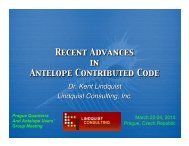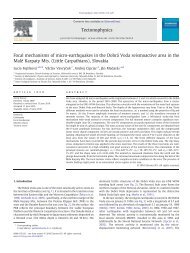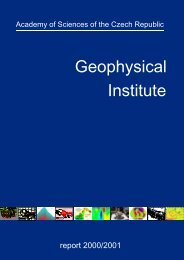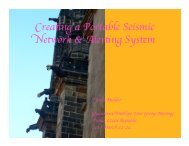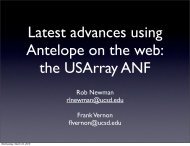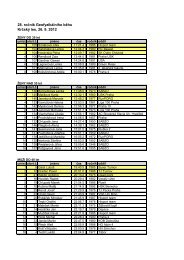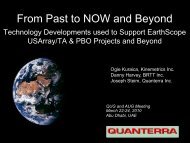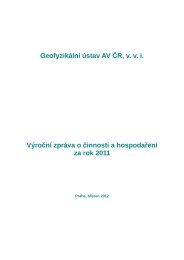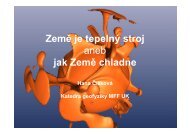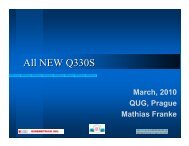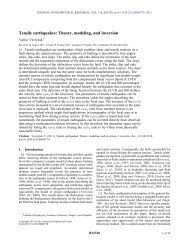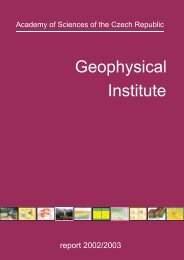Geophysical Institute of the ASCR
Geophysical Institute of the ASCR
Geophysical Institute of the ASCR
Create successful ePaper yourself
Turn your PDF publications into a flip-book with our unique Google optimized e-Paper software.
References<br />
Vavryčuk V., 2005. Focal mechanisms in anisotropic media Geophys. J. Int., 161, 334-346, doi: 10.1111/j.1365-<br />
246X.2005.02585.x.<br />
Vavryčuk V., 2004. Inversion for anisotropy from non-double-couple components <strong>of</strong> moment tensors. J. Geophys. Res., 109,<br />
B07306, doi:10.1029/2003JB002926.<br />
Vavryčuk V., 2006. Spatially dependent seismic anisotropy in <strong>the</strong> Tonga subduction zone: a possible contributor to <strong>the</strong><br />
complexity <strong>of</strong> deep earthquakes. Phys. Earth Planet. Inter., in print.<br />
Vavryčuk V., 2006. Focal mechanisms produced by shear faulting in weakly transversely isotropic crustal rocks. Geophysics,<br />
in print.<br />
Caustics and anti-caustics in seismic anisotropy<br />
Anisotropy <strong>of</strong> rocks significantly complicates properties <strong>of</strong> seismic waves propagating in <strong>the</strong> Earth’s<br />
crust and in <strong>the</strong> mantle. It causes effects, which are not observed in isotropic geological structures.<br />
For example, it generates so-called parabolic lines, caustics, anti-caustics and singularities. It has been<br />
shown that <strong>the</strong>se effects are present not only under strong anisotropy, typical for crystals, but also<br />
under weak anisotropy, which is observed in a majority <strong>of</strong> rocks in <strong>the</strong> Earth. Using numerical<br />
modeling (Fig. 27) we examined basic properties <strong>of</strong> parabolic lines and caustics present in <strong>the</strong> vicinity<br />
<strong>of</strong> all types <strong>of</strong> singularities in homogeneous anisotropic media and we studied <strong>the</strong>ir influence on<br />
seismic wave-fields. The most complicated singularities in anisotropy are <strong>the</strong> conical and wedge<br />
singularities, which generate caustics and anti-caustics in <strong>the</strong>ir vicinity. The parabolic lines cannot<br />
touch or pass through a conical singularity, but <strong>the</strong>y touch each wedge singularity. The size <strong>of</strong> caustics<br />
and anti-caustics depends on strength <strong>of</strong> anisotropy. Caustics and anti-caustics strongly influence<br />
geometry <strong>of</strong> rays <strong>of</strong> seismic waves and induce anomalous properties <strong>of</strong> seismic wave fields. Caustics<br />
cause <strong>the</strong> concentration <strong>of</strong> energy <strong>of</strong> seismic waves, while anti-caustics cause its dissipation.<br />
Knowledge <strong>of</strong> geometry <strong>of</strong> caustics and anti-caustics is essential for a correct modeling <strong>of</strong> seismic<br />
waves generated by an earthquake source.<br />
Fig. 27. Caustics on <strong>the</strong> wave sheets for <strong>the</strong> S1 (right) and S2 (left) waves in strong cubic anisotropy. The inner<br />
circle on <strong>the</strong> S1 sheet denotes anti-caustic. Equal-area projection is used. The plus sign corresponds to <strong>the</strong><br />
vertical direction, <strong>the</strong> outer circles correspond to horizontal directions.<br />
References<br />
Vavryčuk, V., 2003a. Parabolic lines and caustics in homogeneous weakly anisotropic solids. Geophys. J. Int., 152, 318-334.<br />
Vavryčuk, V., 2003b. Behaviour <strong>of</strong> rays near singularities in anisotropic media. Phys. Rev. B, 67, art. no. 54105.<br />
Vavryčuk, V., 2003c. Generation <strong>of</strong> triplications in transversely isotropic media. Phys. Rev. B, 68, art. no. 54107.<br />
42



